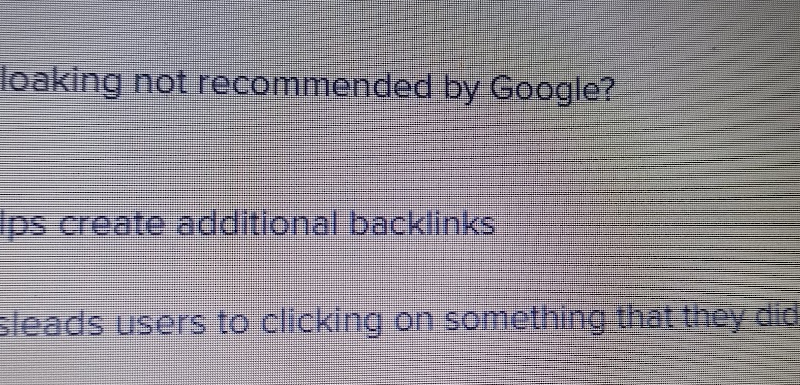Why is Cloaking not recommended by Google
Question: Why is Cloaking not recommended by Google?
Options
It helps create additional backlinks
It misleads users to clicking on something that they didn’t expect
Answer: It misleads users to clicking on something that they didn’t expect
Explanation
Cloaking in SEO is a method used to serve users content or information that is different from what is presented to search engine crawlers (i.e. spiders or bots) to improve a website’s search engine rankings for certain keywords. So, it is clear, that clocking misleads users to click on something which does not exist or expected.
What are the types of cloaking?
- User-Agent Cloaking
- IP based cloaking
- JavaScript cloaking
- HTTP_REFERER cloaking
- HTTP Accept-language header cloaking
1. User-Agent Cloaking:
A user-agent is a program (a software agent) that operates on behalf of a user. Example, a web browser acts as user-agent that fetches website information on an operating system. When you key in a query, the browser sends a code to the server that will distinguish/identify the user-agent. If the user-agent is identified to be a crawler, cloaked content is served.
2. IP-based cloaking:
Every user accessing a website has an IP address based on their location and internet service. In this, the users are redirected to the desired page through a page with good SERP ranking and high traffic volume. For this, you can use the reverse DNS records (available in the cPanel of your hosting company) to identify the IP address and set up .htaccess to redirect them. This is the most preferred method of cloaking.
3. JavaScript cloaking:
This happens when users with JavaScript-enabled browsers are served one version of the content while users who have JavaScript disabled (like search engines) are served another version of a website.
4. HTTP_REFERER cloaking:
In this method, the HTTP_REFERER header of the requester is checked and based on that, a cloaked or uncloaked version of the website is served.
5. HTTP Accept-language header cloaking:
This technique checks the HTTP Accept-Language header of the user and based on the match result, a specific version of the website is presented. In simple terms, if the HTTP Accept-Language header is of a search engine, then a cloaked version of the website is served.
What are the common ways to implement cloaking in SEO?
Let us now understand how to put cloaking into action with a few easy pointers:
Invisible or Hidden text
This can be done by adding text in the same colour as that of the background so that it is not visible to the human eye.
Flash-based Websites
We know Flash is not recommended as per SEO guidelines. But some websites cannot avoid it. So rather than remaking the entire website in plain HTML, they create content-rich webpages and provide them to search engine crawlers and the flash pages to visitors.
HTML Rich Websites
A good SEO technique requires having a “TEXT to HTML ratio” that is as high as possible. In other words, the web page should have more text (content) as compared to your HTML tags. But if someone is writing short articles or posts, your text to HTML ratio will be very low. To avoid re-designing their website in such scenarios, people choose cloaking to meet SEO guidelines.
Replacement of Java Scripts
Here, one can use JavaScript to show content to a non-JavaScript enabled user that matches the textual information within a Flash or other multimedia element.
Conclusion
Cloaking is a greyhat SEO technique. It is not advisable to use to rank your website. Google can penalize your website.

